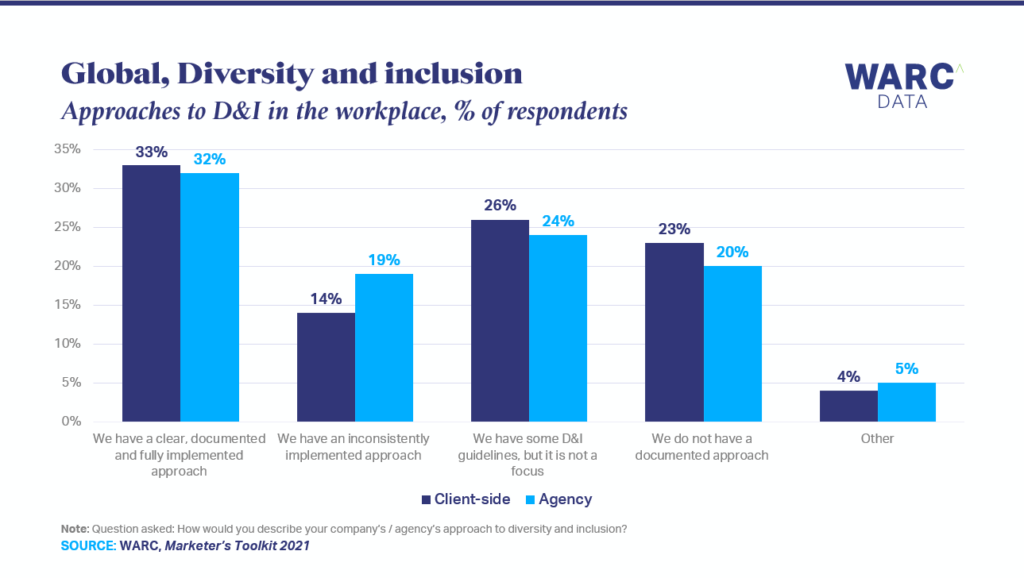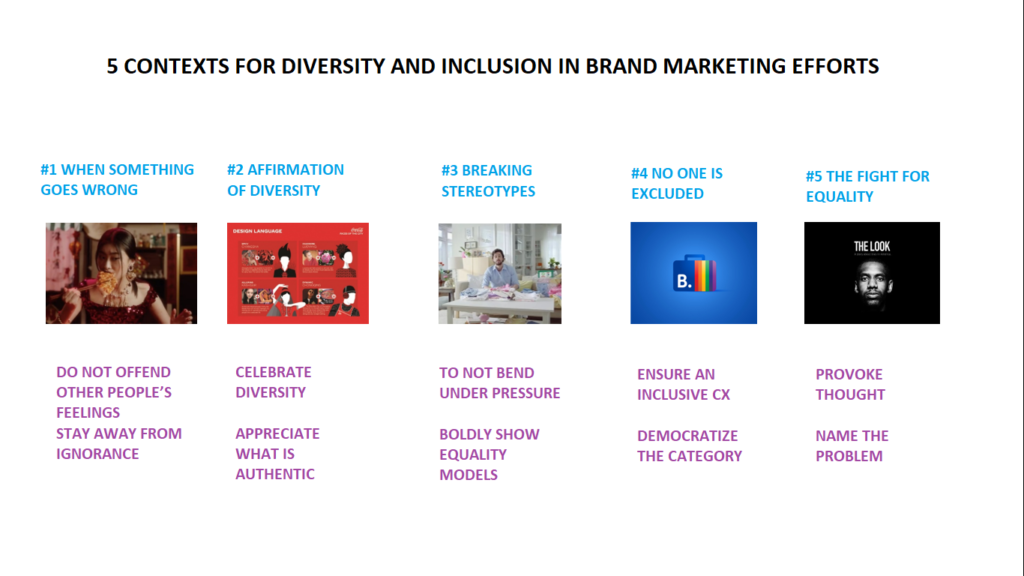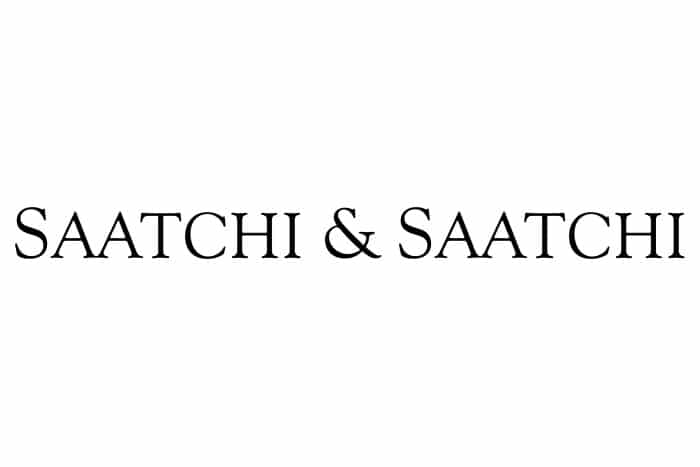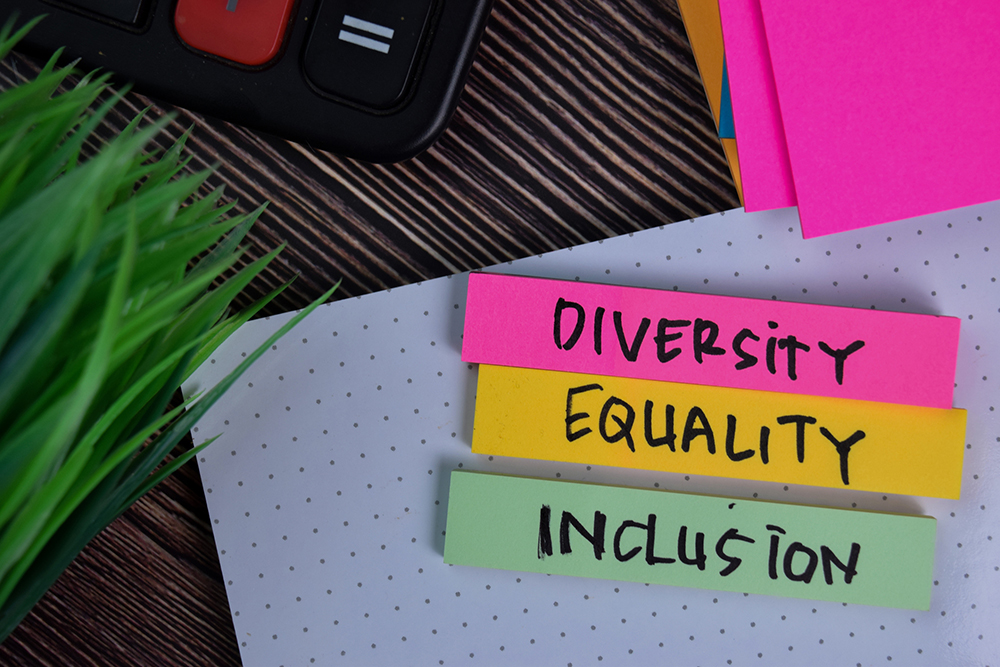Let’s all take a bolder stand for diversity and act about it. Let’s show our commitment to equality and this May 2021 celebrate the European Diversity Month together. With more diverse workplaces, we will create a fairer and more equal Europe for all.
Helena Dalli, , EU Commissioner for Equality

Diversity Charters have been established in Europe since 2004 to provide support and promote best practices in managing diversity. The European platform currently brings together 26 national Diversity Charters that represent more than 12,000 signatory organizations and more than 16 million employees.
How does this look in the marketing industry? According to WARC’s “Marketer’s Toolkit 2021,” about one-third of clients and agencies report having a policy defined and implemented in their organization related to promoting diversity and building an inclusive workplace. In contrast, one in four firms has no formal approach to the topic.

In Poland, the coordinator of the Diversity Charter is Responsible Business Forum, the organizer of Diversity IN Check, which diagnoses the level of maturity of an organization or a company, in terms of diversity management and building an inclusive organization. The results of the survey will be published on May 27 on the profile of the Diversity Charter on FB. At that time we will know the list of employers who are most advanced in promoting good practices related to diversity and inclusion in Poland.
An inclusive work environment through formal regulations and involving company employees in everyday activities
Inclusion is, on the one hand, a matter of regulations, established within the framework of socio-economic policies of the state, and, on the other hand, programs undertaken within companies that can regulate diversity and accelerate change in the desired direction. Representation in the company’s team of people with diverse backgrounds, of different ages, of different genders. Control of equal pay for people with similar competencies and experience, regardless of gender or other variables. Representation of women on boards of directors – these are just a few examples of areas of potential action to shape an integrated and unbiased work environment.
On the other hand, the culture of an organization is shaped by these everyday practices, behaviors and it is worth paying attention to whether they support diversity and are inclusive. Undoubtedly, communication is a powerful tool – it shapes attitudes and behaviours, and reflects the world we would like to live and work in. Gender-sensitive language, free from prejudice and stereotypes, helps to move away from stereotypical ideas about men, women, people with disabilities or other social groups. Some issues are very entrenched, so it is all the more important to be sensitive to the language we use. Even when we have good intentions and want to compliment someone by saying: “you handled it like a man” or “you’re doing great for your age”, we contribute to perpetuating harmful and hurtful stereotypes. Another issue is our everyday behavior and the extent to which it manifests an openness to diversity, e.g. in terms of differing opinions. Theoretically, we may even be aware of the power and importance of diversity. The more different the points of view, the more diversified the team in terms of experience, competence, mindset, the greater the chance to successfully solve complex problems and generate truly innovative ideas. So much for theory, but let the person who can’t say that it is often more pleasant to listen to people who agree with us or represent a similar way of thinking cast the first stone. It’s just the way we’re shaped.
Diversity is neither simple nor intuitive, so it is worth stimulating openness to it
One of the basic mechanisms of the group process is the search for similarities among the members of the forming group. This gives us a sense of security and becomes the first, important glue of the organism, which consists of different individuals. Our natural tendency to simplify the image of the world and the desire to maximize our chances of being accepted will always be our first instinct towards things we know and people we understand better because they are similar to us. All otherness is more difficult because it forces us to make an effort – to understand another point of view, to learn a new perspective, to get out of our comfort zone. It carries a risk – that we will be rejected, misunderstood. It is worth remembering this when recruiting for a team. And although it will be easier to verify to what extent a candidate thinks like us, it is also worth making an effort and wondering to what extent he or she will bring something new to our team. On a daily basis, when forming project teams or conducting meetings, it’s worth making sure that everyone has space to share their opinions. We will be very tempted to quickly establish a common point of view, but this may be to the detriment of the final result. So let’s remember about different techniques and procedures that allow us to control the phenomena of groupthink, such as the “institution” of the devil’s advocate or a person who joins the team at a certain stage of work to look at the results with fresh eyes and comment on them. And for this to work, a work culture where there is openness and everyone feels free to voice their opinions and ideas, and where leaders make sure everyone’s voice is heard, is key.
5 contexts for diversity and inclusion in brand marketing efforts
- WHEN SOMETHING GOES WRONG…
Starting with negative examples, it’s important to note that it’s still relatively common for the topic of diversity to come up when brands make the mistake of not being sensitive enough and introduce discriminatory content into their communications. As in the case of Dolce&Gabbana, which in ads prepared for the Chinese market showed attempts to eat Italian food with chopsticks. The brand was accused of racism and insulting references to cultural heritage. The brand was boycotted and the actress who appeared in the advertisement was stigmatized, which had a negative impact on her career. Gucci in turn experienced a PR crisis when it released a sweater design with a motif that clearly referred to a symbol of oppression of African Americans – the caricatured makeup used in 19th century theaters as part of the makeup of actors playing black characters.
Basing on stereotypes in advertising is very tempting – it allows to communicate a message in a simple way, by activating content already ingrained in the minds of the audience. However, stereotypes or the way they are used can be hurtful and offensive. Most situations seem obvious after the fact, but they still happen. Why? Apart from situations when it is a result of deliberate use of unflattering stereotypes about a specific group, sometimes this can be a result of the lack of knowledge, sensitivity or an insufficient level of diversity within an organization. Gucci, after the sweater mishap, not only apologized but made a systemic change. They created the position of “Global Head of Diversity, Equity & Inclusion” to bring the issue to the forefront and put processes and practices in place to foster equity within the organization and its marketplace operations.

- AFFIRMATION OF DIVERSITY
Coca-Cola’s campaign proves that referring to national heritage does not have to mean profanity, but can become an element of positive communication promoting and celebrating diversity. The brand conducted a campaign in China, which included the launch of limited edition cans dedicated to 23 different cities and using iconic elements of tradition and referring to the unique values of these metropolises. The campaign was created in response to the observed phenomenon of increased migration of young people within the country, which provoked a social debate on regional differences and how the identity of the young generation is shaped. By finding value in diversity, the brand helps to build a sense of pride in one’s roots and identification with the place where one currently lives – despite its differences.
Affirming diversity in brand communications can involve various aspects. Showing models of different ages, appearance and beauty canon by fashion brands is another example that fits in the idea of building diversity as a value.

- BREAKING STEREOTYPES
On the one hand, playing on existing stereotypes is tempting, because it simplifies building a message. On the other hand, breaking stereotypes can be equally tempting – it allows to build a provocative message, which by breaking out of the familiar and obvious has the potential to attract attention and provoke reflection. In the #labelsareforclothes campaign, the riverisland.com brand used people with various disabilities to present clothes, pointing out the negative effect of all kinds of labelling. By also providing visibility to these people. Because if they are part of society and are the recipients of the brand’s products, why are they basically left out as models? Breaking stereotypes or various taboos may concern various aspects, e.g. related to disabilities, canons of beauty, age, gender or social roles. As in the commercials of Ariel washing capsules, in which, contrary to the commonly accepted model, a man takes care of the children and the house, does the laundry, and braids his daughter’s hair.

- NO ONE IS EXCLUDED
Promoting diversity and inclusion is, of course, not only a matter of manifesting these values in communication. Brands can do a lot at the level of how their products and services function. This is about ensuring a truly inclusive brand experience that is the ultimate proof of how serious they are about the subject. The mission of makeup brand Fenty Beauty by Rihanna is to offer beauty for everyone. Embodying this mission, she was the first in the market to take such a detailed approach to mapping out the finest nuances in the color of different complexions. She entered the market with a record 40 shades of foundation. Today the portfolio already has over 50. Another example is a Microsoft product – a game console designed for people with mobility impairments, promoted with the campaign “When everyone plays, we all win”. Or the introduction of Travel Pride by Booking.com. With the idea that some people may be limiting their travel for fear of being judged or even discriminated against. Now anyone can check places to stay in terms of their non-heteronormative friendliness, and booking.com is certifying such places.

- THE FIGHT FOR EQUALITY
Finally, in promoting diversity and equality, brands sometimes take an elevated tone in their communications, highlighting the issue and making people think by calling a spade a spade.
The grocery chain Edeka, in order to express its objection to the spread of xenophobia and racism, has removed all products that are not made in Germany from the store. In this symbolic way they show how impoverished the world would be without foreigners. The Procter&Gamble brand, on the other hand, produced “The Talk” campaign, which won the 2018 Grand Prix at Cannes, and its follow-up “The Look” in 2020. Both dealt with the problem of manifestations of everyday racism told in the first case from the perspective of children and in the second from the perspective of an adult male.

Summary and tips

sources:
https://odpowiedzialnybiznes.pl/diversity-in-chec
https://www.consilium.europa.eu/media/35436/pl_brochure-inclusive-communication-in-the-gsc.pdf


